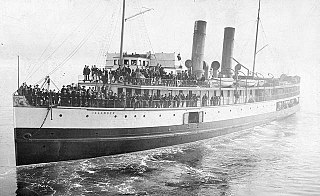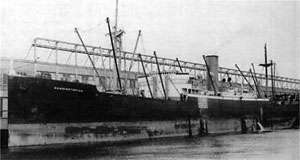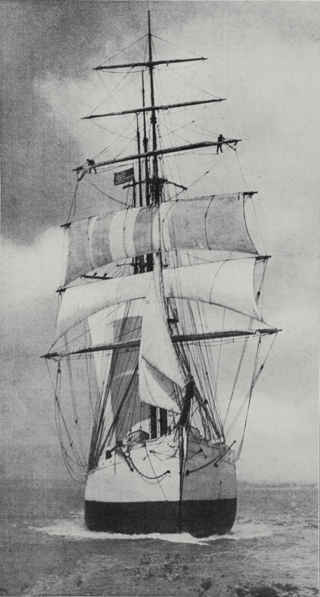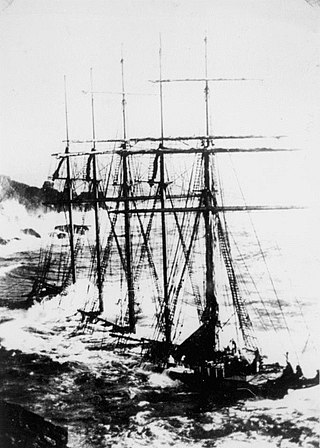Related Research Articles

USS Bear was a dual steam-powered and sailing ship built with six-inch (15.2 cm)-thick sides which had a long life in various cold-water and ice-filled environments. She was a forerunner of modern icebreakers and had a diverse service life. According to the United States Coast Guard official website, Bear is described as "probably the most famous ship in the history of the Coast Guard."

A jackass-barque, sometimes spelled jackass bark, is a sailing ship with three masts, of which the foremast is square-rigged and the main is partially square-rigged and partially fore-and-aft rigged (course). The mizzen mast is fore-and-aft rigged.

Thomas W. Lawson was a seven-masted, steel-hulled schooner built for the Pacific trade, but used primarily to haul coal and oil along the East Coast of the United States. Named for copper baron Thomas W. Lawson, a Boston millionaire, stock-broker, book author, and president of the Boston Bay State Gas Co., she was launched in 1902 as the largest schooner and largest sailing vessel without an auxiliary engine ever built.

The SS Islander was a 1519-ton, 240-foot (73 m) steel hull, schooner-rigged twin-screw steamer, built in Scotland in 1888, and owned and operated by the Canadian-Pacific Navigation Company.

Gustaf Adolf Mauritz Erikson was a ship-owner from Mariehamn, in the Åland islands. He was famous for the fleet of windjammers he operated to the end of his life, mainly on the grain trade from Australia to Europe.

SS Washingtonian was a cargo ship launched in 1913 by the Maryland Steel Company of Sparrows Point, Maryland, near Baltimore, as one of eight sister ships for the American-Hawaiian Steamship Company. At the time of her launch, she was the largest cargo ship under American registry. During the United States occupation of Veracruz in April 1914, Washingtonian was chartered by the United States Department of the Navy for service as a non-commissioned refrigerated supply ship for the U.S. fleet stationed off the Mexican coast.

USC&GS Yukon was a schooner that served as a survey ship from 1878 to 1894 in the United States Coast Survey, which was renamed the United States Coast and Geodetic Survey in 1878. She was the pioneering Coast Survey or Coast and Geodetic Survey ship in many of the waters of the Territory of Alaska, including the Bering Sea and the western Aleutian Islands, and she also operated extensively in California and Washington. She later entered commercial service as Elwood and was wrecked in 1895.

HMS Wasp was a Banterer-class composite screw gunboat of the Royal Navy, built in 1880 by Barrow Iron Shipbuilding and wrecked off Tory Island in 1884.

SS Princess Kathleen was a passenger and freight steamship owned and operated by Canadian Pacific Steamships. She served the coastal communities of British Columbia, Alaska and Washington.

Sunny South, an extreme clipper, was the only full-sized sailing ship built by George Steers, and resembled his famous sailing yacht America, with long sharp entrance lines and a slightly concave bow. Initially, she sailed in the California and Brazil trades. Sold in 1859 and renamed Emanuela, she was considered to be the fastest slaver sailing out of Havana. The British Royal Navy captured Emanuela off the coast of Africa in 1860 with over 800 slaves aboard. The Royal Navy purchased her as a prize and converted her into a Royal Navy store ship, Enchantress. She was wrecked in the Mozambique Channel in 1861.

Amaranth was a four-masted barquentine built by Matthew Turner of Benicia, California in 1901. Amaranth sailed in the China trade between Puget Sound and Shanghai. She was wrecked on a guano island in the South Pacific in 1913 while carrying a load of coal.

Matthew Turner was an American sea captain, shipbuilder and designer. He constructed 228 vessels, of which 154 were built in the Matthew Turner shipyard in Benicia. He built more sailing vessels than any other single shipbuilder in America, and can be considered "the 'grandaddy' of big time wooden shipbuilding on the Pacific Coast."

Carrier Dove was a four-masted schooner built by the Hall Brothers in Port Blakely in 1890. She worked in the West coast lumber trade and in fishing.

Adolf Vinnen was a five-masted barquentine that was built by Friedrich Krupp Germaniawerft, Kiel, Germany. She was wrecked on her maiden voyage in 1923.

Princess May was a steamship built in 1888 which was operated under a number of different names and owners. The ship is best known for having been involved in a grounding in 1910 which left the ship jutting completely out of the water, which became the subject of a famous shipwreck photograph.

Cymric was a British and Irish schooner, built in 1893. She joined the South American trade in the fleet of Arklow, Ireland, in 1906. She served as a British Q-ship during the First World War; she failed to sink any German U-boats, but did sink a British submarine in error.

The Star of Bengal was an iron three-masted 1,877 GRT merchant sailing vessel built in Belfast in 1874 by Harland and Wolff Industries. Though built towards the end of the Age of Sail, she was successfully operated for 24 years by the British trading company J.P. Corry & Co. The ship mainly travelled on the London-Calcutta trading route, but made a few voyages to Australian and American ports.
John Peck was an American merchant and naval architect of the 18th century. He had been trained as a merchant, and as apprentice in that matter had served at sea as supercargo for a few voyages. Having become interested in naval architecture while studying mathematics in school, the experiences of observing ships at sea furthered that interest. It would appear, however, that his designing of ships was more of a hobby, compared to his main trade as a successful merchant. Additionally, he was appointed inspector of saltpeter in Watertown, Massachusetts, around the time the American Revolution started.
Northland Transportation Company operated cargo and passenger ships from Seattle to Southeast Alaska starting in 1923. During World War II Northland Transportation Company was active in charter shipping with the Maritime Commission and War Shipping Administration. Northland Transportation Company, proposed a loan from United States Shipping Board to build a ship for Puget Sound-Alaska trade in 1933. In 1934, the company was granted a $350,000 loan to build a new ship. The 1,400 tons passenger ship, was built at Lake Washington Shipyard in Houghton, Washington. Northland Transportation Company Seattle dock and warehouse were at Pier 56, now Ainsworth and Dunn Wharf.
References
- ↑ Lyman, John (13 September 1941). Pacific Coast Built Sailers, 1850-1905. The Marine Digest. p. 2.
- ↑ "Steamers disabled through heavy weather". The Times . No. 40450. 18 February 1914. p. 15.
- ↑ Chapelle, Howard (1935). The History Of American Sailing Ships. W. W. Norton & Co., Inc. pp. 290–292.